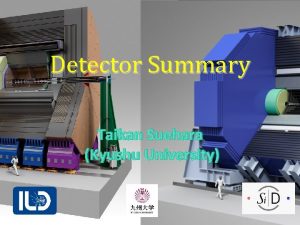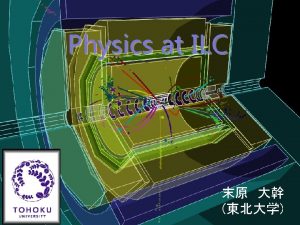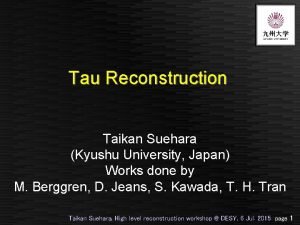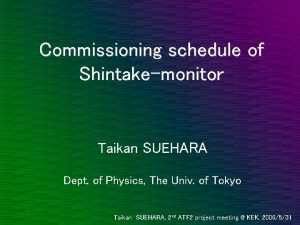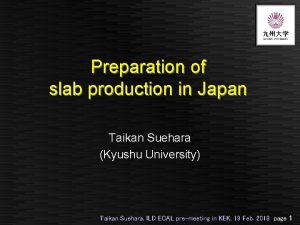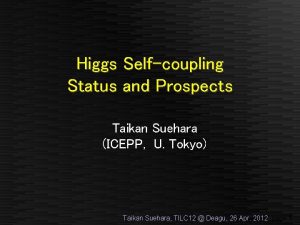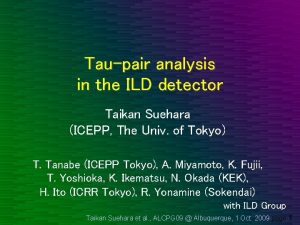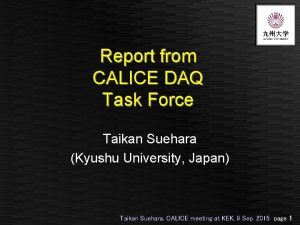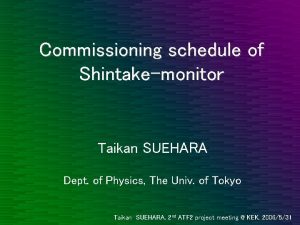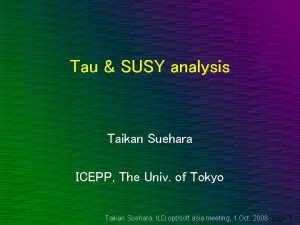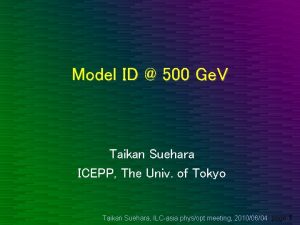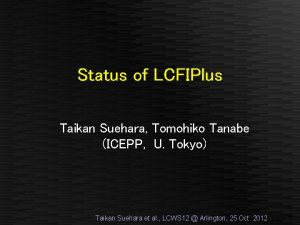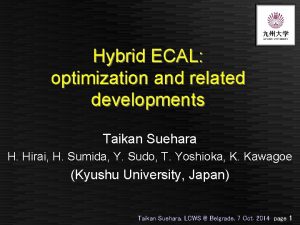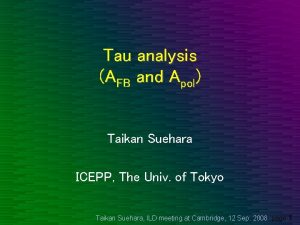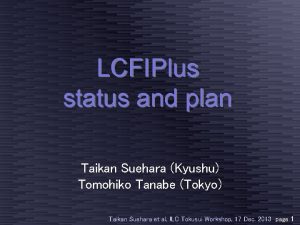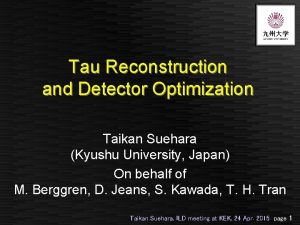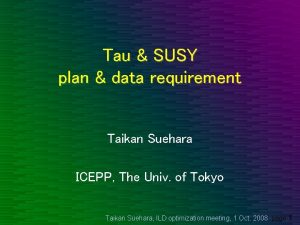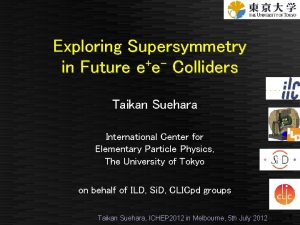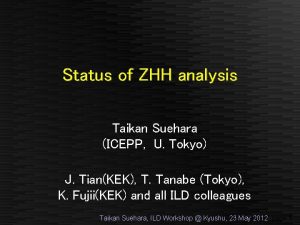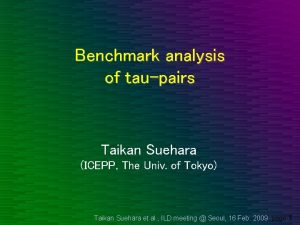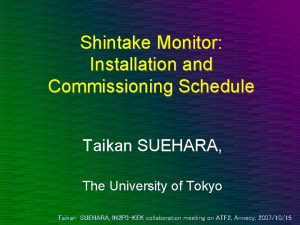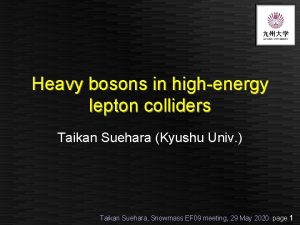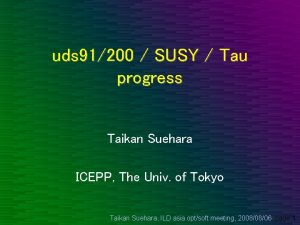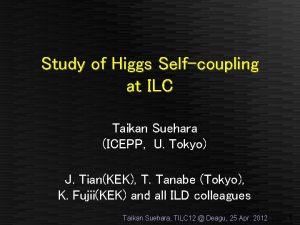Requirements from CALICEDAQ for WP 5 Taikan Suehara

























- Slides: 25

Requirements from CALICE-DAQ for WP 5 Taikan Suehara (Kyushu University, Japan) Taikan Suehara, AIDA-2020 kickoff meeting, 3 Jun. 2015 page 1

CALICE-DAQ introduction • Three types of calorimeter being actively developed – Silicon ECAL – Scintillator strip ECAL / Analog HCAL – Semi-digital RPC HCAL • Individual DAQ hardware and software – Conceptually based on UK(~2008) scheme Si. ECAL (2012) Sc. ECAL+AHCAL (2014)kickoff meeting, SDHCAL (2014) Taikan Suehara, AIDA-2020 3 Jun. 2015 page 2

CALICE DAQ Structure TLU? Not realized yet HDMI Ethernet USB tracker etc. CALICE Master CCC Clock, start/stop, validation, busy PC Si CCC PC Sc CCC SDHCAL SDCC PC Wing. LDA / Mini. LDA DCC RPI data LDA / GDCC data Si DIF Sc DIF SDHCAL DIF SKIROC SPIROC HARDROC Taikan Suehara, AIDA-2020 kickoff meeting, 3 Jun. 2015 page 3

First trial of Si+Sc TB 2014 Sc. CCC as master 1 Si layer upstream Sc. ECAL + AHCAL (~1 m) EUDAQ + adapter used Timing synchronization confirmed Taikan Suehara, AIDA-2020 kickoff meeting, 3 Jun. 2015 page 4

CALICE DAQ Task Force • Experts’ meeting discussing common DAQ • Members – Silicon: R. Cornat, F. Magniette, T. Suehara – Scintillator: J. Kvasnicka, M. Reinecke – Semi-digital HCAL: L. Mirabito, C. Combaret • 2 years of mandate • ~ 1 meeting per month – 5 meetings held – First agreement is being made for hardware Taikan Suehara, AIDA-2020 kickoff meeting, 3 Jun. 2015 page 5

Targets of CALICE DAQ TF • Common DAQ – Common clock and acquisition cycle (AQC) – Synchronized data taking and event matching – Common run control – Interface to upper control (TLU) • Combined testbeam • Minimize total work by sharing tasks • Currently ‘minimal effort’ basis – Acceptable combination with minimal effort Taikan Suehara, AIDA-2020 kickoff meeting, 3 Jun. 2015 page 6

Hardware / Firmware Mainly based on discussion in CALICE DAQ TF with some personal bias Taikan Suehara, AIDA-2020 kickoff meeting, 3 Jun. 2015 page 7

TLU and CALICE Master-CCC • Common function of TLU and MCCC – Provide common clock (BX clock? ) – Busy & validation – Start/Stop Acquisition cycle (AQC) • MCCC-only function: – Provide synchronized configurable fast clock – Configurable delay of Start/Stop AQC – HDMI serialized format for start/stop – At least three output HDMI for each technology Possible to combine TLU and CALICE master CCC? (+ even individual CCCs (Si, Sc, SD) kickoff ? ) meeting, 3 Jun. 2015 Taikan Suehara, AIDA-2020 page 8

Running mode: TB spill CCC start stop LDA Busy clear For maximum efficiency at testbeam Taikan Suehara, AIDA-2020 kickoff meeting, 3 Jun. 2015 page 9

Running mode: ILC “AQC” CCC start stop LDA Spill (optional) – 5 Hz, 1 ms livetime in ILC, variable in TB – Preferred for power-pulsing operation – Data quality should be monitored Taikan Suehara, AIDA-2020 kickoff meeting, 3 Jun. 2015 page 10

TLU: misc • Master clock can be assumed as ‘BX’ clock – Some of CALICE subsystem may not accept this directly • ‘Start’ and ‘Stop’ should be synchronized to the clock • Scintillator subsystem requires dedicated LED calibration run at some period – No need for Si and SDHCAL Taikan Suehara, AIDA-2020 kickoff meeting, 3 Jun. 2015 page 11

HDMI between CCC & LDA CCC LDA 1. Clock (freq. varies by subsystem) 2. Validation (or trigger) 3. Serialized command line – 8 b/10 b encoding in some subsystems – Common commands defined (like start/stop) LDA CCC 1. Busy (either oscillating or non-oscillating) 2. Serialized data transfer (not used) (used for LDA DIF communication) Taikan Suehara, AIDA-2020 kickoff meeting, 3 Jun. 2015 page 12

Master CCC • Not realized yet (DESY or/and Kyushu will contribute) – Planned to be implemented in Zync FPGA • Overlap of function with TLU – We expect compatibility with non-TLU run and TLU run Taikan Suehara, AIDA-2020 kickoff meeting, 3 Jun. 2015 page 13

Software Not discussed yet in CALICE DAQ TF, so this is mainly my personal opinion… Taikan Suehara, AIDA-2020 kickoff meeting, 3 Jun. 2015 page 14

Software • Common DAQ needs common software for – Run control and configuration – Data integration, monitoring and validation • Requirement for Common DAQ – Flexibility – (At least some) support – Scalability to at least full layer prototype • Multiple DAQ machine – Upgradability to real ILC DAQ Taikan Suehara, AIDA-2020 kickoff meeting, 3 Jun. 2015 page 15

LCIO trasfer • LCIO is our common data format • LCIO cannot be easily transferred via TCP – SIO uses stream but hard-coded to file IO – ‘Major effort’ needed to modify that but we desire to do so • Can be contributed by this WP? Taikan Suehara, AIDA-2020 kickoff meeting, 3 Jun. 2015 page 16

LCIO structure for CALICE raw data • Format of raw data is not structured in LCIO – Usually LCGeneric. Object is used – Something like ‘Raw. Calo. Data’ is desired • Main components of raw data – Address – LDA/DIF ID (optional), ASIC ID, cell ID, event buffer ID (usually 0 -15) – Time component: Run, AQC, BX – Several analog or digital data per every cell • ADC, TDC, trig/hitbit etc. – Condition variables (temperature etc. ) – Should be easily calibrated Taikan Suehara, AIDA-2020 kickoff meeting, 3 Jun. 2015 page 17

EUDAQ From my personal observation of EUDAQ 1. 4. 1, not EUDAQ 2 Taikan Suehara, AIDA-2020 kickoff meeting, 3 Jun. 2015 page 18

EUDAQ: structure • In the current EUDAQ structure projectspecific codes are not well separated from core • We want to compile minimum-core + ILC specific + LCIO (and not Eutelescope which requires broader range of ILCsoft) • Dynamic loading of DLL may be necessary Taikan Suehara, AIDA-2020 kickoff meeting, 3 Jun. 2015 page 19

EUDAQ: communication • We would keep the independence of individual DAQ frameworks • Well-defined communication protocol is desired between EUDAQ and individual DAQ • Controlling EUDAQ from scripts is also desired • One proposal – Configuration by xml which can be transferred via TCP as well as gotten from a file – Each control command is communicated with xml structure, can be communicated from scripts as well – Data can be exchanged in a desired format by users, for us LCIO if available… Taikan Suehara, AIDA-2020 kickoff meeting, 3 Jun. 2015 page 20

EUDAQ: scalability • Our (quasi-final) prototype may consist of – ~ 1 k ASICS, ~ 100 k channels per subsystem – Should be acquired by 1 -10 PC per subsystem – Of course integration to 1 PC should be a bottleneck parallel acquisition is necessary – Real ILC: ~ 1 M ASICS, ~ 100 M channels O(1 k) PCs? Taikan Suehara, AIDA-2020 kickoff meeting, 3 Jun. 2015 page 21

EUDAQ: contribution from CALICE • ‘CALICE’ part of EUDAQ should be controlled by us, with support from coredevelopers – Of course contribution from core-developers are mostly very welcome • We want to propose or contribute to corecode as well • We need regular communication for codevelopment of EUDAQ and CALICEEUDAQ Taikan Suehara, AIDA-2020 kickoff meeting, 3 Jun. 2015 page 22

Misc: condition database • Condition should be stored and managed at some good coordination – – – Easy interface (from web, from script, etc. ) Accessibility from the web Access control Safety (backup, conflict, etc. ) Local replication (for testbeam etc. ) Flexible structure (multiple calibration, etc. ) • What to store (example) – Layer structure (LDA#, DIF#, ASIC#. . . ) – Calibration constants and settings (gain, noise, bias HV etc. ) – General condition (place, TB used, failure, repair etc. ) Taikan Suehara, AIDA-2020 kickoff meeting, 3 Jun. 2015 page 23

Misc: beam interface • Communication to facility (accelerator) is usually not well established during the short TB period • Standard interface is important • Desired functions: – Logging various accelerator parameter • Stored on condition database? ? – Easy access online/offline – Time stamping according to run/AQC/(BX) • Maybe receiving TLU Taikan Suehara, AIDA-2020 kickoff meeting, 3 Jun. 2015 page 24

Summary • We recognize that CALICE-DAQ related work is a big part of WP 5, and WP 5 is important for CALICE-DAQ • For hardware, TLU and master CCC should be in close connection • For software, closer collaboration is needed for further development Taikan Suehara, AIDA-2020 kickoff meeting, 3 Jun. 2015 page 25
 Offentlig förvaltning
Offentlig förvaltning Roliga rim till lärare
Roliga rim till lärare Nyckelkompetenser för livslångt lärande
Nyckelkompetenser för livslångt lärande Mantel som bars av kvinnor i antikens rom
Mantel som bars av kvinnor i antikens rom Tidbok
Tidbok Vilken grundregel finns det för tronföljden i sverige?
Vilken grundregel finns det för tronföljden i sverige? Formuö
Formuö Ministerstyre för och nackdelar
Ministerstyre för och nackdelar Bamse för de yngsta
Bamse för de yngsta Verktyg för automatisering av utbetalningar
Verktyg för automatisering av utbetalningar Skivepiteldysplasi
Skivepiteldysplasi Tillitsbaserad ledning
Tillitsbaserad ledning Vem räknas som jude
Vem räknas som jude Romarriket tidslinje
Romarriket tidslinje Boverket ka
Boverket ka Mästare lärling modell
Mästare lärling modell Varför kallas perioden 1918-1939 för mellankrigstiden?
Varför kallas perioden 1918-1939 för mellankrigstiden? Verksamhetsanalys exempel
Verksamhetsanalys exempel Matematisk modellering eksempel
Matematisk modellering eksempel Texter för hinduer tantra
Texter för hinduer tantra Centrum för kunskap och säkerhet
Centrum för kunskap och säkerhet Kyssande vind
Kyssande vind Inköpsprocessen steg för steg
Inköpsprocessen steg för steg Sura för anatom
Sura för anatom Strategi för svensk viltförvaltning
Strategi för svensk viltförvaltning Novell typiska drag
Novell typiska drag


























